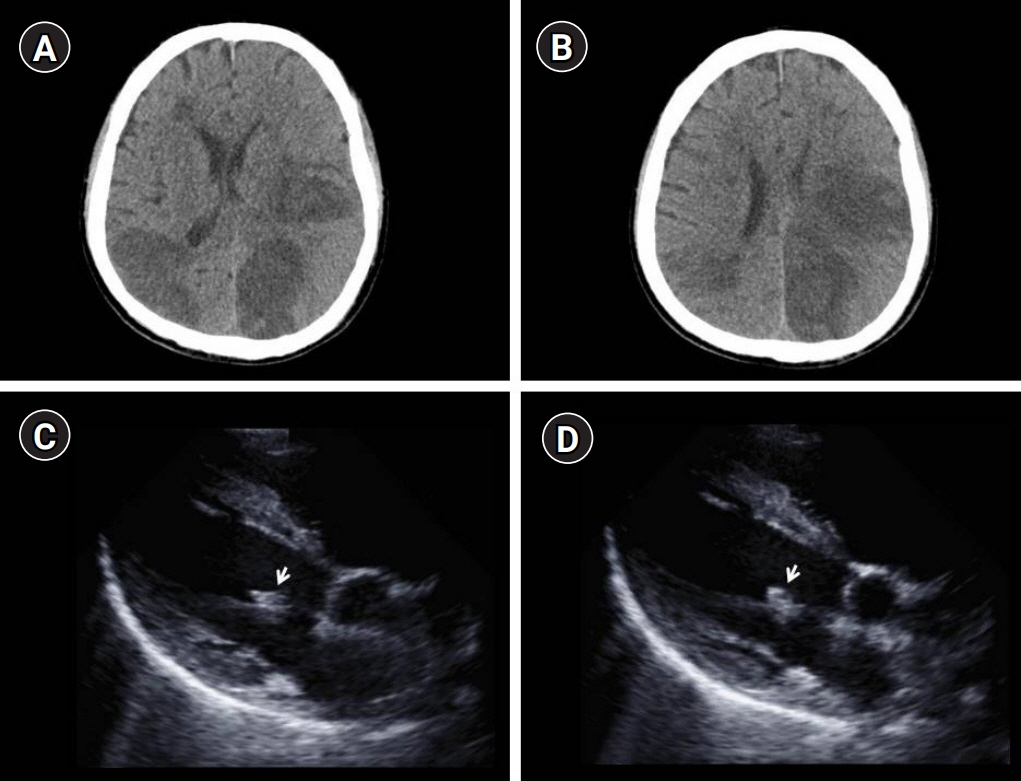J Neurocrit Care.
2020 Dec;13(2):101-104. 10.18700/jnc.200019.
Cerebral infarction caused by endocarditis in a patient with COVID-19
- Affiliations
-
- 1Department of Neurology, Keimyung University School of Medicine, Daegu, Republic of Korea
- 2Department of Internal Medicine, Keimyung University School of Medicine, Daegu, Republic of Korea
- KMID: 2509939
- DOI: http://doi.org/10.18700/jnc.200019
Abstract
- Background
Coronavirus disease 2019 (COVID-19) has become a worldwide health threat due to its highly contagious nature and severe complications. The authors experienced a case of cerebral infarction caused by endocarditis in a patient infected with Severe acute respiratory syndrome coronavirus 2 (SARS-CoV-2).
Case Report
A 65-year-old male patient with COVID-19 was admitted to our hospital for cohort isolation. On day 11 after admission, the patient suddenly presented right-sided hemiparesis. Computed tomography of the brain showed multiple hypodense lesions, which confirmed acute cerebral infarction. Transthoracic echocardiogram revealed a vegetation of about 5 mm on the mitral valve and endocarditis was diagnosed as the cause of cerebral infarction.
Conclusion
Cerebral infarction is one of the complications of COVID-19 and can occur at any time during the course of the disease. Hence, a neurologist has an important role in the medical team involved in COVID-19 treatment.
Keyword
Figure
Reference
-
1. Huang C, Wang Y, Li X, Ren L, Zhao J, Hu Y, et al. Clinical features of patients infected with 2019 novel coronavirus in Wuhan, China. Lancet. 2020; 395:497–506.
Article2. Chen N, Zhou M, Dong X, Qu J, Gong F, Han Y, et al. Epidemiological and clinical characteristics of 99 cases of 2019 novel coronavirus pneumonia in Wuhan, China: a descriptive study. Lancet. 2020; 395:507–13.
Article3. Thuny F, Grisoli D, Collart F, Habib G, Raoult D. Management of infective endocarditis: challenges and perspectives. Lancet. 2012; 379:965–75.
Article4. Murdoch DR, Corey GR, Hoen B, Miró JM, Fowler VG Jr, Bayer AS, et al. Clinical presentation, etiology, and outcome of infective endocarditis in the 21st century: the International Collaboration on Endocarditis-Prospective Cohort Study. Arch Intern Med. 2009; 169:463–73.5. Snygg-Martin U, Gustafsson L, Rosengren L, Alsiö A, Ackerholm P, Andersson R, et al. Cerebrovascular complications in patients with left-sided infective endocarditis are common: a prospective study using magnetic resonance imaging and neurochemical brain damage markers. Clin Infect Dis. 2008; 47:23–30.
Article6. Mao L, Jin H, Wang M, Hu Y, Chen S, He Q, et al. Neurologic manifestations of hospitalized patients with coronavirus disease 2019 in Wuhan, China. JAMA Neurol. 2020; 77:1–9.
Article
- Full Text Links
- Actions
-
Cited
- CITED
-
- Close
- Share
- Similar articles
-
- A Case of Infective Endocarditis in which Cerebral Infarction and Hemorrhage developed together
- Malignant cerebral infarction after COVID-19 myocarditis in 22-year-old female: a case report
- Stroke in a Young Age COVID-19 Patient: Vasculitis Feature and Changes in Cerebral Vessel Stenosis
- A Patient with Corpus Callosum Infarction Accompanying Infective Endocarditis
- A Case of Early Valve Replacement for Haemophilus parainfluenzae Endocarditis Complicated with Acute Cerebral Infarctions


